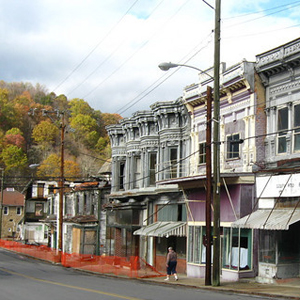Platted in 1881 and accessed by the Norfolk and Western Railroad two years later, this company town was built by the Southwest Virginia Improvement Company. Situated amidst 31,000 acres of rugged land on a thick seam of high-grade bituminous coal, the town grew southward from a small assemblage of buildings along Laurel Creek to occupy the nearby hillsides with the town cemetery and mines lying to the north. The residential quarter, aggregated near the creek, was comprised primarily of frame duplex houses enclosed by white picket fences along tree-lined streets. The hillside commercial district consists primarily of linear blocks of two-story, brick structures interrupted by occasional stone constructions and the Italianate City Hall built in 1895. The company store stretches almost an entire block and another more ornate commercial structure retains its pressed metal façade. Reflecting the mining company’s diverse ethnic mix, the town once utilized as many as thirty churches.
Pocahontas Mine Number 1, which operated from 1882 to 1955, lies a short distance east of the town center. Once the hub of mining operations with 400 coke ovens and miles of interconnected railroads, the site has now been revegetated. A fan house constructed around 1900 and a power generating house and stone bathhouse erected shortly thereafter retain their historic integrity and, along with the mine, are operated by the town of Pocahontas as a tourist destination. The Pocahontas Historic District was listed on the National Register of Historic Places in 1972 and Pocahontas Mine Number 1 became a National Historic Landmark in 1994.




